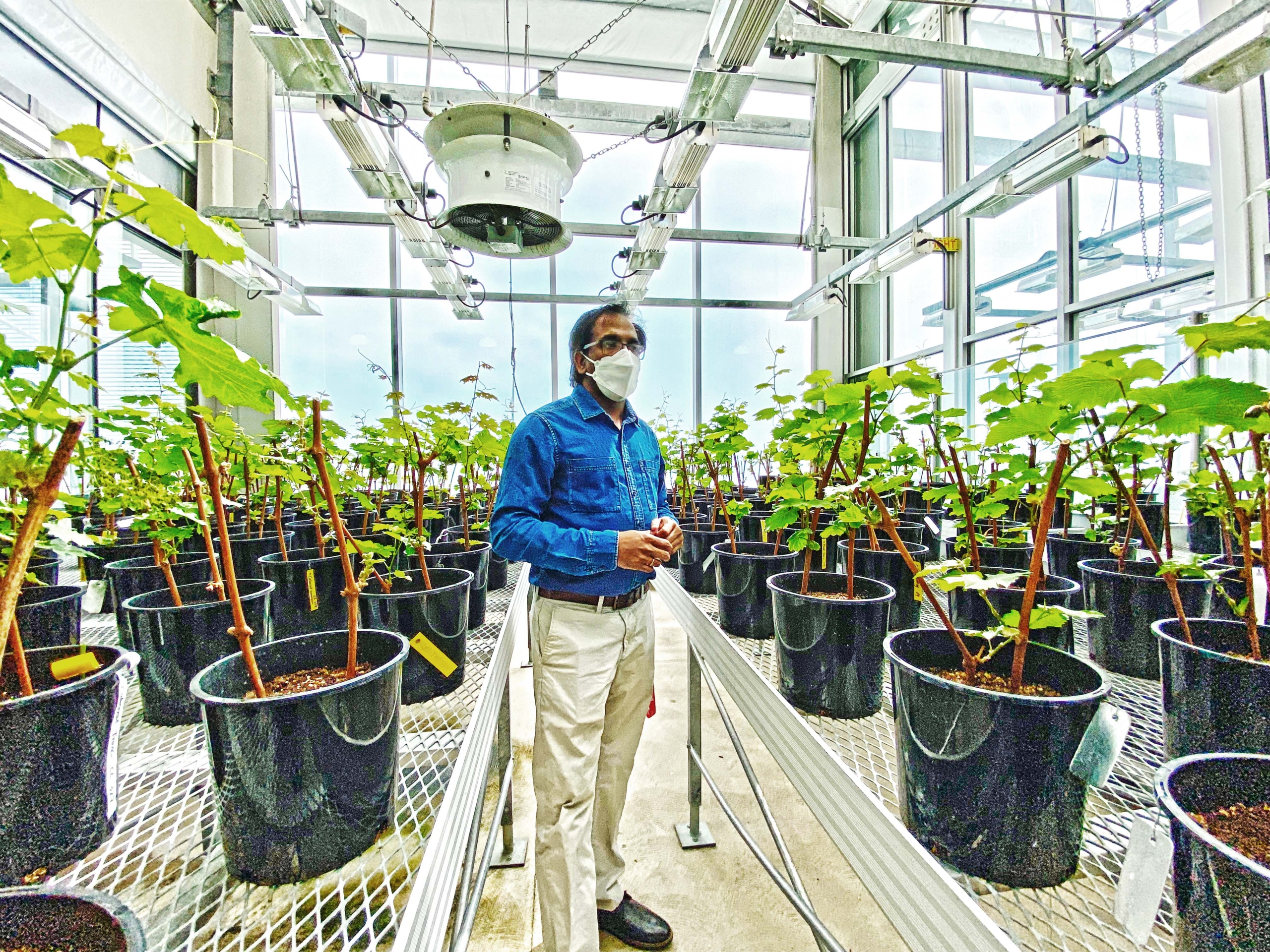University one big step closer to providing industry with safe, healthy plants
Tucked away in a small greenhouse inside the Cairns BioSciences building at Brock University, 57 varieties of grapevines are flourishing in their climate-controlled environment.
They represent a key development in the battle against viruses that cause extensive damage in Niagara’s vineyards.
The grapevines are guaranteed virus-free and they are the first step toward creating a local supply of clean material for nurseries and growers.
“This will make the industry sustainable and provide the quality we need to compete,” says Matthias Oppenlaender, chair of the Grape Growers of Ontario
Viruses pose a significant threat to growers in Niagara.
“It costs $30-35 thousand per acre to plant a vineyard and it takes three to five years before the vines produce a full crop. You could lose it all because of viruses. Growers can’t afford it any more,” Oppenlaender explained.
“It’s critical the industry has access to virus-free material, for the quality of the grapes.”
Until now, the only source of certified virus-free grapes in Canada was in Saanich, B.C., on Vancouver Island. “This repository at Brock gives us a second leg to stand on,” said Oppenlaender.
“Brock is an ideal facility. They can test existing vines, and propagate clean material for new vines,” he said.
Sudarsana Poojari, senior staff scientist at Brock University’s Cool Climate Oenology and Viticulture Institute acknowledges it’s a long process, but he has big plans.
“We plan to expand. We’ll prune and maintain these plants, then expand into larger greenhouses and eventually develop a vineyard with larger numbers for propagation,” he said.
“The goal is to become self-sufficient, so we won’t have to purchase from other countries, like France and the United States. Niagara imports approximately half a million vines each year and the countries we import from may not care about the specific viruses that we are concerned with.”
“The two viruses that are most damaging in Niagara are red blotch disease and leaf roll disease. They affect fruit quality, especially sugar levels,” Poojari said.
No one knows exactly how widespread those viruses are, but experts agree it’s a critical issue.
“There is a consensus in the industry about the importance of clean vines and the pay off in the long run,” said Ethan Churchill, project manager for the Canadian Grapevine Certification Network.
The industry group’s mission is to make sure growers and wineries have access to clean, quality grapevine material.
“It’s extremely anecdotal evidence, but many vineyards are affected by red blotch and leaf roll. They’re quite prevalent, but the information can be confidential,” Churchill said.
“Disease can spread and it becomes a bit like a bonfire. If you don’t control it, it can destroy a vineyard,” he said.
The viruses also seem to make vines more likely to suffer damage from extreme cold.
Vineyards were seriously damaged by last winter’s extreme cold and the yield this season is expected to drop by at least 50 per cent as a result.
“It’s not scientific but it appears that virus-free vines are more winter hardy,” said Oppenlaender.
“Where we have viruses, we see more winter damage,” said Wade Stark, vineyard operations manager for Andrew Peller Ltd.
He plans to pull out 17 acres of Merlot and Pinot Noir vines that were badly affected by winter injury at Clark Farm on Concession 6, and “many growers are facing the same replant scenario that we are at this time,” he said.
Stark believes a virus was responsible for much of the damage.
“In the Merlot block, we had previously tested, and there was a fairly high virus plant count, with an estimated more than 60 per cent virus-infected. “
He will only replant with vines that have been certified virus-free by the Canadian Grapevine Certification Network.
“It’s an added layer of insurance against planting with infected material. Nothing is perfect, nor guaranteed, but we are all in this together as an industry and anything we can do to ensure top-quality grapes and wines will help us all achieve success in our shared goals of economic sustainability,” he said.
Grape and tender fruit industry expert and consultant Ryan Brewster recommends all growers plant certified vines.
“I highly advise clients to start with certified clean material. It costs a bit more but it’s definitely worthwhile,” he said.
“I think viruses are far more prevalent than anyone thinks. It requires testing to know if a virus is present and testing is expensive,” he added.
“To transition a vineyard is a long process and virus transition will have to wait until winterkill is dealt with,” he said.
Oppenlaender hopes growers will make virus-free vines a priority as they deal with winterkill.
“This is a crisis, but it’s also an opportunity for growers to say, ‘If I have to replant, let’s do it with virus-free material, even if I have to wait a year or two.’ It takes two years to get new vines usually anyway, and once the vines are planted they will produce for at least 25 years, and as much as 40,” he said.
Nurseries can contact the grapevine certification network to get virus-free material from Brock, “then they can take that generation one and plant it, and then propagate a mother block from that,” he explained.
Back in that small greenhouse, with the beginnings of an expanding repository of clean vines, Poojari admits there is much work still to do, but maintains his optimism.
“We lag 20 years behind the U.S. industry. They started in the 1980s, and they have five or six centres across the U.S. with standards, protocols and clean plant programs,” he said.
“We are small, but we are getting there.”










